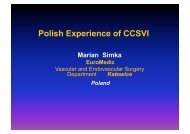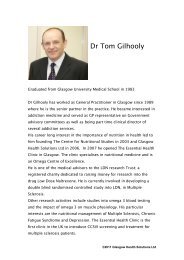ISNVD Abstract Book
ISNVD Abstract Book
ISNVD Abstract Book
Create successful ePaper yourself
Turn your PDF publications into a flip-book with our unique Google optimized e-Paper software.
Does metal-induced hypersensitivity, a risk factor for<br />
venous stenosis and restenosis, contribute to brain and<br />
venous abnormalities in multiple sclerosis sufferers?<br />
Stejskal V PhD 1 , Tsamopoulos N MD 2 , Manginas N MD 3<br />
1<br />
Dept of Immunology, University of Stockholm. 2 Dept of Interventional Neuroradiology, Mediterraneo Hospital, Athens, Greece. 3 Dept of Interventional Cardiology, Mediterraneo Hospital, Athens, Greece<br />
PURPOSE<br />
RESULTS<br />
We asked why restenosis occurred in the majority of multiple sclerosis patients treated by percutaneous transluminal angioplasty (PTA) for<br />
<br />
subsequent<br />
restenosis after PTA.<br />
<br />
34 patients with central nervous (CNS) and systemic symptoms suspected to have been caused by dental amalgam. Similar changes were not<br />
<br />
® <br />
patients with CNS symptoms and MRI changes were found against inorganic mercury, phenyl mercury, gold and lead.<br />
INTRODUCTION<br />
<br />
observed reduced signal density on T2 weighted magnetic resonance images (MRI) of the basal ganglia in the brain of MS patients and<br />
<br />
areas of low density in T2 weighted imaging and the location of iron deposits as well as the correlation between the extent of gray matter T-2<br />
<br />
An important factor for restenosis, sometimes observed after cardiovascular stenting, is immune reactivity to metals in the stents. Thus, cellular<br />
hypersensitivity (Type 4, delayed type allergy) to stent materials increases the risk for restenosis in patients who are patch test positive to nickel<br />
<br />
Thus, patients suffering from gold allergy developed restenosis more frequently than similarly treated non-allergic patients, or patients with gold<br />
allergy but implanted with nickel or titanium-coated stents (Fig 1). The frequency of gold sensitization increases with the number of dental gold<br />
restorations. Further, in addition to cadmium and lead, which induce arrhythmias and high blood pressure, many studies indicate the role of<br />
<br />
In addition to patch testing, metal allergy may be diagnosed by determining the presence of memory T lymphocytes in peripheral blood.<br />
This so-called Lymphocyte Transformation Test (LTT) has been used for many years and has been standardized and validated in the form of<br />
MELISA ® ® detects abnormal cellular reactivity in patients suffering from<br />
<br />
is shown in Fig 2 and described in more detail below. The clinical relevance of MELISA ® <br />
reactivity following the replacement of sensitizing metals with non-metallic dental materials. In mercury-allergic patients suffering from multiple<br />
<br />
<br />
<br />
<br />
<br />
MATERIALS AND METHODS<br />
FIG 1<br />
FIG 2<br />
MELISA ® - MEmory Lymphocyte Immuno Stimulation A<br />
<br />
present in the environment and in dental restorations, as well as from other sources (Figs 3 and 4).<br />
<br />
FIG 3<br />
<br />
FIG 4<br />
<br />
<br />
Interestingly, titanium dioxide (TiO 2 ), previously thought to be “bio-inert”, stimulated the MS patients’ lymphocytes. Exposure to TiO 2 is very<br />
common, since it is added to pharmaceutical drugs as well as to foods, cosmetics and supplements. Titanium activates vein endothelial cells in<br />
vitro<br />
Further, TiO 2 <br />
<br />
<br />
and abnormal deposition of iron in the brain and veins of MS patients.<br />
Accumulation of iron around the vein endings in the gray matter and the presence of lymphocytes and macrophages around demyelinating<br />
plaques could be due to dissemination of metal ions released from dying blood macrophages entering the brain through a damaged blood brain<br />
barrier.<br />
Local brain macrophages (oligodendrocytes) might further ingest the metal debris and become damaged in the process. Since<br />
<br />
CONCLUSION<br />
<br />
<br />
deposits in the basal ganglia.<br />
<br />
<br />
<br />
<br />
<br />
FIG 11<br />
FIG 12 <br />
<br />
TABLE 1<br />
<br />
<br />
(SI). A value over 3 indicated a positive reaction to the given allergen.<br />
Baksi R et al. Gray matter T2 hypointensity is related to plaques and atrophy in the brain of multiple sclerosis patients. J Neurol Sci 2001; 185: 19-26<br />
Dreyer BP et al. Magnetic resonance imaging in multiple sclerosis; decreased signal in thalamus and putamen. Ann Neurol 1987; 22: 546-550<br />
Ekqvist S et al. High frequency of contact allergy to gold in patients with endovascular coronary stents. Br J Dermatol 2007; 157: 730–738<br />
Guo M et al. Ti(IV) uptake and release by human serum transferrin and recognition of Ti(IV) – transferrin by cancer cells: understanding the mechanisms of action of the anti-cancer drug Titanocene dichloride. Biochemistry 2000 Vol 39(33): 10023-33<br />
Houston MS. Role of Mercury Toxicity in Hypertension, Cardiovascular Disease, and Stroke. J Clin Hypertens (Greenwich)2011; 13: 621–627<br />
Köster R et al. Nickel and molybdenum contact allergies in patients with coronary in-stent restenosis. Lancet 2000; 356: 1895-1897<br />
Nemmar A, Melghit K, Badreldin H.Exp Biol Med 233: 610–619, 2008<br />
Prochazkova J et al.Neuroendocrinol Lett 2004; 25(3): 211–218<br />
Svedman C et al. A correlation found between contact allergy to stent material and restenosis of the coronary arteries. Contact Dermatitis 2009; 60: 158–164<br />
Stejskal V et al. MELISA - an in vitro tool for the study of metal allergy. Toxic. in Vitro 1994(8), No. 5: 99-1000<br />
Stejskal V et al. Diagnosis and treatment of metal-induced side-effects: Neuroendocrinol Lett 2006, 27 (Suppl. 1): 7-16<br />
Tibbling L et al. Immunological and brain MRI changes in patients with suspected metal intoxication. Int J of Occupational Medicine and Toxicol 1995; 4: 285-294<br />
Virtanen JK et al. Mercury, Fish Oils, and Risk of Acute Coronary Events and Cardiovascular Disease, Coronary Heart Disease, and All-Cause Mortality in Men in Eastern Finland. Arterioscler Thromb Vasc Biol. 2005; 25: 228-233<br />
Wagner M et al. Heavy metals ion induction of adhesion molecules and cytokines in human endothelial cells. Pathobiology 1997; 65: 241-252<br />
Zamboni P et al.Journal of Vascular Surgery 2009(50); 6: 1348-1358<br />
Zamboni P et al. J R Soc Med. 2006 Nov; 99(11): 589-93<br />
Zamboni P et al. CCSVI in patients with multiple sclerosis. J Neurol Neurosurg Psych 2009, 80: 392-399




